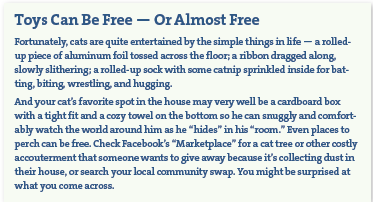Like all pure creatures, cats are practical,” said American Beat Generation author and feline fan William S. Burroughs. That means you can be practical, too, cutting costs without cutting into your cat’s health or contentment in your home.
You’ve already got the advantage over dog owners. According to figures compiled last year by the ASPCA, it costs almost $1,400 annually to have a dog, compared to only about $1,150 for a cat. Dog food ends up being more expensive, along with vaccines and wellness visits — even toys. The only item in the cat column that people with dogs don’t have to purchase is litter. The ASPCA estimates it costs about $150 a year.
But even for litter there’s a way to tamp down on cost. Here are some options for tending to your cat — or cats — on a budget.
Keep up on routine healthcare at home
If you make a habit of taking proper care of your cat’s health needs, you can cut down greatly on veterinary expenses.
- Brush your cat’s teeth. At a certain point your cat is going to need regular teeth cleanings, each of which will set you back a couple hundred dollars — largely because of the anesthesia needed to keep a cat still during the process. But “regular” can vary from every 6 months to every 2 years depending on the advice of your pet’s veterinarian. If you brush your cat’s teeth at least every other day, they will be in better shape and may require less frequent cleanings. Not only that, you will help avoid serious periodontal disease, which can cost hundreds, if not thousands, of dollars to treat.
- Brush your cat’s fur about once a week, or use a metal comb if he is short-haired. It won’t only help your cat look his best. It will also remove dirt, grease, and dead hair from his coat, not to mention cut down on hairballs. In addition, it will help remove loose skin flakes and improve circulation, all of which contribute to optimum health.
Don’t skimp on medications
Purchase the medicines every cat needs to stay healthy: heartworm preventatives, along with flea and tick medicine. Heartworm disease, flea infestation, and tick borne illness are much more expensive to treat than to prevent. Be sure to purchase the brands the doctor prescribes; this is not the place to skimp by ordering online without a prescription. It is tempting to cut costs that way, but you cannot be certain you will be sent medication that is effective or up to date, or even that the product will contain the ingredients the label says it does.
The core vaccines are critical preventatives, too: feline herpesvirus (FHV-1), feline calicivirus (FCV), feline panleukopenia, known idiomatically as distemper (FPL), and, for cats younger than one year of age, feline leukemia (FeLV). The doctor may also advise a vaccine against rabies along with the other shots. Don’t save money by skipping any of these health-preserving preparations. The risk of having to pay large sums to treat the diseases these medicines protect against is just not worth it.
Speaking of risk avoidance…
Just as you want to insure against illness by purchasing the preventive medicines all cats need, insure yourself by purchasing actual pet health insurance. The ASPCA lists health insurance as one of the necessary costs of having a cat. They estimate it at about $350 a year, or $29 a month. It may seem unnecessary when your cat is young, but chances are quite high that you’ll appreciate having it later on.
When possible, buy in bulk
At one local veterinary clinic, a three-pack box of medicine that prevents against fleas, ticks, and heartworm costs $78; a six-pack box, $135. That’s $26 per pack versus $22.50; it adds up.
Buying large-size containers of your cat’s staples — food and litter — will pay off, too, if laying out the extra money for the bigger amount is something your budget will allow. At a Boston-area supermarket, a bag of a particular brand of cat food that weighs 3.15 pounds costs $7.49 — or $2.38 per pound. The same cat food in a much larger 13-pound bag costs $17.99 — only $1.39 per pound.
When it comes to litter, we found 14 pounds of a certain brand for $8.99; 20 pounds for $10.49; and 40 pounds for $16.49. Going from smallest container to largest, that translates to 64 cents a pound, 52 cents a pound; and 41 cents a pound. These differences are not insignificant.
 Some people like to buy in bulk at warehouse-like club stores or online, and that could provide a further cost savings — but not necessarily. The club stores have annual memberships that cut into the savings, and depending on the item, the savings might not be all that impressive to begin with. And while buying in bulk online and having items sent to your door is very convenient, shipping costs could eat up any savings on the products themselves. Do some price comparisons before you go with either one of those routes to make sure you’re coming away with the savings you believe you are.
Some people like to buy in bulk at warehouse-like club stores or online, and that could provide a further cost savings — but not necessarily. The club stores have annual memberships that cut into the savings, and depending on the item, the savings might not be all that impressive to begin with. And while buying in bulk online and having items sent to your door is very convenient, shipping costs could eat up any savings on the products themselves. Do some price comparisons before you go with either one of those routes to make sure you’re coming away with the savings you believe you are.




